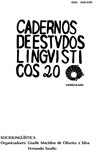Resumo
-Referências
BATESON, Gregory.1972. Steps to an Ecology of Mind. New York: Ballentine.
BIRDWHISTELL, R. L. 1961. Paralanguage Twenty-five Years After Sapir. in J. Laver and S. Hutcheson (orgs.) Face-to-face Communication. Harmondworth: Penguin, 1972.
ERICKSON, F. e J. Schultz. 1982. The Councelor as Gatekeeper: Social Interaction in Interviews. N.Y.: Academic Press.
ERICKSON, F. e J. Schultz. 1977. When is a context? some issues and methods in the analysis of social competence. in Ouarterly Newsletter of the Institute for Comparativa Human Development 1(12): 5-10.
FALK, Jane.1979. The duet as a conversational process. PhD Dissertation. University of California, at Berkeley.
FREUD, Sigmund. 1969 [1940). An Outline of Psychoanalysis. N.Y.: W.W. Norton. Traduzido por J. Strachev,29-39.
HALL, E. T. 1973 (1959). The Silent language. N.Y.: Anchor Books. GOFFMAN, Ervin. 1974. Frame Analysis. New York: Harper and Row.
GOFFMAN, Ervin. 1981. Footing. In Forms of Talk. Philadelphia: University of Pennsylvania Press, 124-59.
LABOV e FANSHELL. 1977. Therapeutic Discourse: Psychotherapy as Conversation. N.Y.: Academic Press.
LAKOFF, Robin. 1980. When talk is not cheap: psychotherapy as conversation. In L. Michaels and C. Ricks, State of language. Berkeley: University of California Press, 440-448.
LAKOFF, Robin. 1985. Schizophrenia as communication. Review of S. Schwartz, language and Cognition in Schizophrenia. Semiotica, 34, 3/4: 355-374.
PHILIPS, Susan U. 1972. Participant structures and communicative competence; Warm Spring children in community and classroom. In C. Cazden, V. John e D. Hymes (orgs.) Functions of language in the Classroom. N.Y : Academic, 370-94.
PHILIPS, Susan U. 1974. Warm Spring "Indian time": how the regulation of participation affects the progression of events. In Bauman, R. e J. Sherzer (org.) Explorations in the Ethnography of Speaking. Cambridge: Cambridge University Press.
QUENTAL-ALMEIDA, L 1987. Clinical interpretation and the reframing of experience: evidence from therapeutic discourse. PhD Dissertation, Georgetown University.
SCHIFFRIN, D. 1982. Discourse markers: semantic resources for the construction of conversation. Ph. D. Dissertation, University of Pennsylvania.
SCHIFFRIN, D. 1987. Discourse Markers. Cambridge: Cambridge University Press.
SCHULTZ, J., S. Florio e F. Erickson. 1982. Where's the floor? aspects of the cultural organization of social relationships in communication at home and in school. in Gilmore e Glatthorn (orgs.) Children In and Out of School Washington, D.C.: Center for Applied Linguistics.
TANNEN, D. 1979. What's in a trame? surface evidence for underlying expectations. In R. Freedle (org.) New Directions in Discourse Processing. Norwood: Ablex.
TANNEN, D. 1985. Frames and schemas in the discourse analysis of interaction. Quarderni di Semantica 6(2).
TANNEN, D. 1986. That's Not What Meant! How Conversational Style Makes or Breaks Relationships. New York: Ballantine Books.
TANNEN, D. e C. Wallat. 1987. Interactive trames and knowledge schemas in interaction: examples from a medical interview. In Social Psychology Quarterly 50 (2): 205-16.
O periódico Cadernos de Estudos Linguísticos utiliza a licença do Creative Commons (CC), preservando assim, a integridade dos artigos em ambiente de acesso aberto.

